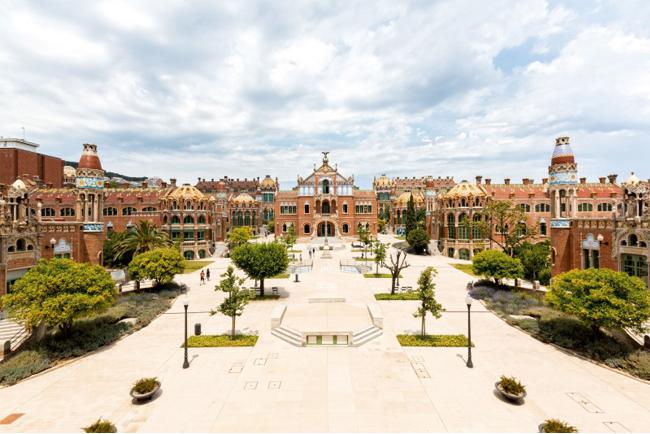Online bookings
24 hours a day
0044 (0) 20 3239 1595
English Phone
Mon-Fri: 8-16:00 GMT
Customer Service
Have you ever thought of visiting a hospital because of its beauty? In Barcelona this is a possibility if you head towards the wonderful Hospital de Sant Pau (St. Paul's Hospital), a building with a unique architectural style that has a long history to tell and is hidden away in a modern green space that not many people know about.

Nowadays, the Hospital of Sant Pau no longer offers all the medical functions that it did in the past. Since 2009, its new headquarters were inaugurated in a health complex that is located somewhat separately in the northwest corner of this modernist building. This was done in order to enable the Private Foundation of the Hospital of Santa Creu and Sant Pau to manage the maintenance and conservation of the building's significant artistic heritage. It is possible to visit the Hospital of Sant Pau and the wonderful interior and exterior of this wonderful complex. It is recommended to visit the building's facade at different times of the day and view it from the Avenida de Gaudí as this is the only way that you will be able to observe the varying nuances that are bestowed on the building's decorations by the different light depending on the time of day. In order to access, it is necessary to purchase an entry ticket which costs €14.00 or €9.80 for children and pensioners. For an additional €3.00, you can visit the building with an audio-guide or you can ask your private guide to accompany you. Depending on your requirements, they can come and collect you and then explain all the information about the building in detail.
The full name is the Hospital de la Santa Creu i Sant Pau, but it is commonly known just as the Hospital of Sant Pau. Its history began way back in 1401 when the Hospital de la Santa Creu resulted from the merger of six hospitals that existed in Barcelona and were governed simultaneously by a lay and a catholic institution which still exists today: the MIA (the Very Illustrious Administration). At the end of the 19th century, the city underwent a significant socio-economic transformation which brought about great progress in the field of medicine and health and which was the reason why it was necessary to expand the hospital and the construction of the new building was begun. This building work was financed by the banker, Pau Gil, and this was why the title of St. Paul (Sant Pau) was added to the name of the hospital which now had an impressive new headquarters. The architect who developed the project was Lluís Domènech i Montaner, the same man who had been responsible for the creation of the Palau de la Musica Catalana and The House of Dragons (in the Parc de la Ciutadella): it is one of the most wonderful modernist attractions in Barcelona which doesn't just include the building itself, but also the delightful complex of buildings and gardens which, in 1997, were declared a UNESCO World Heritage Site.
The Hospital of Sant Pau is situated in an idyllic location as, from the top of the Avenida de Gaudí, it looks out towards the Sagrada Familia: so there are two modernist beauties within a radius of 1000 meters. The easiest way to get to the Hospital of Sant Pau in Barcelona is to take the Metro, either on the Violet Line L2 or the Blue Line L5 and get off at the stop for the Sagrada Familia.
Together with the Palau de la Música Catalana, the Hospital of Sant Pau de Barcelona was incorporated into the UNESCO list of assets in 1997 as a symbol of the artistic trend of Catalan modernism. In fact, this was an exuberant symbol of the Art Nouveau movement that flourished in Barcelona in the early 20th century. In addition to its massive facade in the Gothic style which is decorated with heraldic mosaics and coats of arms, the building is surrounded by plenty of outdoor spaces which are embellished by the beautiful gardens as well as an enormous underground level which is dedicated to the service areas. However, what makes the site so special, is not just its aesthetic appearance. Yes, all the different areas are decorated with bright mosaics and sculptures (created by the most famous artists of the period), but what really adds true value to the hospital is the concept that it promotes: that the beauty of the place represents a real contribution to the patients' well being. This important ideal has been carried through time, so much so that today, the hospital complex of Santa Creu i Sant Pau in Barcelona houses a space called the Kālida Sant Pau: it is a cozy setting in which you can receive complementary assistance in conjunction with your medical care and is based precisely on the idea of the curative value of design and architecture. The Kālida Sant Pau occupies an area of 400 square meters within the hospital complex and is hidden by a large garden.
My comments